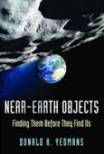Dr. Paul Rybski, UWW Dept. of Physics, will give a one-hour talk about “Recent Asteroid Discoveries and Possible Collisions with Earth” on Fri., Oct. 11, at 8pm in Upham 140. It’s the second lecture in the 2013-2014 Whitewater Observatory Lecture Series. A public viewing session at Whitewater Observatory will follow the lecture at 9:15pm, weather permitting. All lectures are free, and everyone is invited to attend!
Andersen Library may be able to provide additional materials if you’d like to learn more. Search HALCat for books, government documents, and videos. Search article databases for articles in journals, magazines, or newspapers. Ask a librarian for assistance with finding materials.
 Examples of items you could find are the book (I love this title!) Near-Earth objects: Finding them before they find us (3rd-floor Main Collection, QB651 .Y46 2013) and a NASA document Near-Earth object survey and deflection: Analysis of alternatives. Report to Congress (online–which you may be able access once the government shutdown ends). Try, for example, a keyword search for “collisions with earth.” Search databases to find Congressional materials like the hearing held on March 19, 2013 by the House Committee on Science, Space, and Technology called Threats from space: A review of U.S. Government efforts to track and mitigate asteroids and meteors (Part I & Part II). UWW students and staff may use this link to see the results of a search in EBSCOhost for “near earth” and SU collisions, and ScienceDirect and the Institute of Physics Electronic Journals would be very good databases to search for articles.
Examples of items you could find are the book (I love this title!) Near-Earth objects: Finding them before they find us (3rd-floor Main Collection, QB651 .Y46 2013) and a NASA document Near-Earth object survey and deflection: Analysis of alternatives. Report to Congress (online–which you may be able access once the government shutdown ends). Try, for example, a keyword search for “collisions with earth.” Search databases to find Congressional materials like the hearing held on March 19, 2013 by the House Committee on Science, Space, and Technology called Threats from space: A review of U.S. Government efforts to track and mitigate asteroids and meteors (Part I & Part II). UWW students and staff may use this link to see the results of a search in EBSCOhost for “near earth” and SU collisions, and ScienceDirect and the Institute of Physics Electronic Journals would be very good databases to search for articles.
LECTURE ABSTRACT:
Asteroids — the remnants of the planetesimals that formed the Earth and other planets and that today number in the millions — are found principally between the orbits of Mars and Jupiter. But well over 10,000 of these are known to cross Earth’s orbit around the Sun, and any one of these could cause significant damage to life on Earth if it hit us. Astronomers know such a collision will happen in the future because it has happened in the past. So we are observing these 10,000 Earth-crossing asteroids and determining their changing orbits so that space agencies can plan on altering the orbits of those asteroids that might hit us in the future.
Tonight’s lecture will briefly review the history of asteroid discovery, concentrating on discoveries since 1980 when the majority of the Earth-crossing asteroids were found. Impressive animations will be shown that display the orbits of 600,000 asteroids over hundreds of years and also show which of these have a chance of hitting Earth. I will also discuss briefly the history of speculation that a large, yet unknown asteroid or planet would have hit Earth last December 21st, fulfilling the false interpretation of the Mayan calendar predicting disaster on this date. You will leave this lecture knowing why modern astronomers assert there is no such asteroid or planet as well as knowing what on-line tools you can use to simulate the amount and kind of damage that would be done on Earth by a specific type and size of asteroid colliding at a specific angle and speed into either an ocean or a continent.
And plan ahead to attend other lectures in this series, which will address damage to or the destruction of the Earth!
- Oct. 18: a possible comet collision during the Pleistocene era
- Nov. 1: future blasting of Earth by a supernova explosion of a nearby star
- Nov. 8: future loss of Earth’s magnetic field, and
- Nov. 15: unpredicted meteor that exploded over Russia last February.
 Andersen Library is a federal and Wisconsin depository library with federal and state government documents on a variety of current and relevant issues available to you in various formats (print, DVD/CD-ROM, online). Check out your government at Andersen Library!
Andersen Library is a federal and Wisconsin depository library with federal and state government documents on a variety of current and relevant issues available to you in various formats (print, DVD/CD-ROM, online). Check out your government at Andersen Library!
